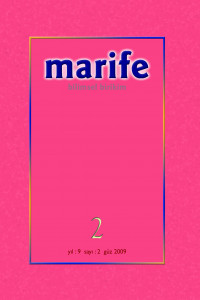Abstract
It is possible to say, the first sensation about body privacy had the same age with the mankind when Prophet Adam and his wife tried to cover their private places appeared due to their mistakes. Body concealing of a person in an "unnatu-ral" manner since not seen in other living beings corresponds to a "value" judg-ment taking shape in sensation and thinking world beyond his natural needs. Cov-ering a part of the body with a cloth does not point out to a purely physical effort but keeping himself away from information and secluded in a sense of no social sharing. At the same time, a person’s each covering is the formation of a distinc-tive social place for himself and making himself "the other" by forming a distance with the others. By the help of this distance, the individual escapes from being subjected to external effects and becomes "free" as he can decide the form of communication with the others. Therefore, body privacy is actually the transfor-mation action of body into a symbol. Because body is not symbolized as a pure body but as the sensation, thought and belief shelter of top values. In this paper, the abovementioned intellectual frame is taken into consid-eration as how it has taken shape by the help of Koran and Sunna, and the Islamic arguments concerning "valuable body created in a most beautiful manner and en-trusted to person" sensation were examined in opposition to "negative body" sen-sation traced throughout the history. The consideration of body privacy of people in two different terms "seeing" and "being seen", the formation of a responsibility area related to morality and law aspects and the characteristic of body privacy not accepting any sexual and also age distinctions are the other subjects of the paper.
References
- Ahmed b. Hanbel (241/855), el-Müsned, I-VI, trs.
- Ay, Eyüp, “Örtünmenin Tarihsel Görünümleri ve Sembolik Anlam(lar)ı”, İslâmiyât, yıl: IV, sy. 2 (Örtünme), ss. 11-18.
- el-Buhârî, Muhammed b. İsmail (256/869), el-Câmiu’s-Sahîh, I-VIII, el-Mektebetü’l-İslâmî, İstanbul 1979.
- Çelikoğlu, Nalan, Türkiye’de Üniversite Gençliğinde Mahremiyetin Dönüşümü, Yayınlanmış Yüksek Lisans Tezi, M.Ü. Sosyal Bilimler Enstitüsü, İstanbul 2007.
- Çelikoğlu, Nalan, Mahremiyet -Kişiye Ait Özel Alan Tartışmaları-, İskenderiye Yayınları, İstanbul 2008.
- ed-Dârimî, Abdullah b. Abdurrahmân (255/868), es-Sünen, I-II, Thk. ve Thr. Fevvâz Ahmed Zümerlî-Hâlid es-Seb’ el-Alîmî, Dâru’l-Kütübi’l-Arabî, Beyrut 1987.
- Devellioğlu, Ferit, Osmanlıca-Türkçe Ansiklopedik Lugat, Aydın Kitabevi, Ankara 2001.
- Doğan, Mehmet, Büyük Türkçe Sözlük, İz Yayıncılık, İstanbul 1996.
- Duman, Zeki, “Kur’an’da Örtünmenin Temel Sınırları”, İslâmiyât, yıl: IV, sy. 2 (Örtünme), ss. 35-52.
- Ebû Dâvûd, Süleymân b. Eş’as es-Sicistânî (275/889), es-Sünen, I-IV, Haz. Muhammed Muhyiddîn Abdülhamîd, el-Mektebetü’l-İslâmî, İstanbul trs.
- Göle, Nilüfer, Modern Mahrem –Medeniyet ve Örtünme-, Metis Yayınları, İstanbul 1998.
- Görmez, Mehmet, “İlâhî Dinlere Göre Başörtüsü”, İslâmiyât, yıl: IV, sy. 2 (Örtünme), ss. 19-33.
- el-Hâkim en-Nîsâbûrî, Muhammed b. Abdullah (405/1014), el-Müstedrek ale’s-Sahîhayn, I-IV, Thk. Mustafa Abdülkâdir Atâ, Dâru’l-Kütübi’l-İlmiyye, Beyrut 1990.
- Halîl b. Ahmed (175/791), Kitâbü’l-Ayn, I-VIII, thk. dr. Mehdî el-Mahzûmî, Mektebetu’l-Hilâl, trs.
- İbn Mâce, Ebû Abdullah Muhammed b. Yezîd (273/887), es-Sünen, I-II, Thk. Muhammed Fuâd Abdülbâkî, Dâru’l-Hadîs, Kahire 1994.
Abstract
Hz. Âdem ve eşinin, işledikleri hata sonucu mahrem yerleri ortaya çıkınca cennet yapraklarıyla örtünmeye çabaladıkları düşünüldüğünde, bedenin mahremi-yetine dair ilk algının insanla yaşıt olduğunu söylemek mümkündür. İnsanın, diğer canlılarda görülmemesi anlamında "doğal" olmayan bir tarzda bedenini gizlemesi, bunun tabii ihtiyaçların ötesinde, duygu ve düşünce dünyasında ortaya çıkan bir "değer" yargısına tekabül ettiğini göstermektedir. Örtü ile bedenin bir kısmını ka-patmak, salt fiziksel bir çabaya değil, insanın kendini gözlerden ve bilgiden uzak tu-tarak bir anlamda sosyal paylaşıma kapatmasına işaret etmektedir. Her örtünme, aynı zamanda kişinin kendine özgü bir sosyal mekân teşekkül ettirmesi ve başkaları ile arasına mesafe koymasıdır. Bu mesafe sayesinde dış etkilere maruz kalmaktan kurtulan birey, diğerleriyle iletişiminin formuna kendisi karar verecek şekilde "özgürleşmekte"dir. Dolayısıyla beden mahremiyeti, aslında bedeni bir simgeye dönüş-türme eylemidir. Zira beden, beden mahremiyeti sayesinde, salt beden olarak değil, bir tür üst değerlerin yani hassas duygu, düşünce ve inançların sığınağı olacak şe-kilde simgeleşmektedir. Bu makalede yukarıda ele alınan düşünsel çerçevenin Kur’an ve Sünnet ta-rafından nasıl şekillendirildiği ele alınmakta, tarih boyunca izi sürülen "olumsuz be-den" algısının aksine, İslâm’ın "en güzel şekilde yaratılarak insana emanet edilen değerli beden" algısına dair argümanları incelenmektedir. Nasslarda beden mahre-miyetinin "gören" ve "görünen" açısından iki farklı bağlamda ele alınması, ahlâkî ve hukukî yönden bir sorumluluk alanı oluşturması ve cinsiyet hatta yaş gibi ayrımlar tanımayan niteliği, makalenin diğer konularıdır.
Keywords
References
- Ahmed b. Hanbel (241/855), el-Müsned, I-VI, trs.
- Ay, Eyüp, “Örtünmenin Tarihsel Görünümleri ve Sembolik Anlam(lar)ı”, İslâmiyât, yıl: IV, sy. 2 (Örtünme), ss. 11-18.
- el-Buhârî, Muhammed b. İsmail (256/869), el-Câmiu’s-Sahîh, I-VIII, el-Mektebetü’l-İslâmî, İstanbul 1979.
- Çelikoğlu, Nalan, Türkiye’de Üniversite Gençliğinde Mahremiyetin Dönüşümü, Yayınlanmış Yüksek Lisans Tezi, M.Ü. Sosyal Bilimler Enstitüsü, İstanbul 2007.
- Çelikoğlu, Nalan, Mahremiyet -Kişiye Ait Özel Alan Tartışmaları-, İskenderiye Yayınları, İstanbul 2008.
- ed-Dârimî, Abdullah b. Abdurrahmân (255/868), es-Sünen, I-II, Thk. ve Thr. Fevvâz Ahmed Zümerlî-Hâlid es-Seb’ el-Alîmî, Dâru’l-Kütübi’l-Arabî, Beyrut 1987.
- Devellioğlu, Ferit, Osmanlıca-Türkçe Ansiklopedik Lugat, Aydın Kitabevi, Ankara 2001.
- Doğan, Mehmet, Büyük Türkçe Sözlük, İz Yayıncılık, İstanbul 1996.
- Duman, Zeki, “Kur’an’da Örtünmenin Temel Sınırları”, İslâmiyât, yıl: IV, sy. 2 (Örtünme), ss. 35-52.
- Ebû Dâvûd, Süleymân b. Eş’as es-Sicistânî (275/889), es-Sünen, I-IV, Haz. Muhammed Muhyiddîn Abdülhamîd, el-Mektebetü’l-İslâmî, İstanbul trs.
- Göle, Nilüfer, Modern Mahrem –Medeniyet ve Örtünme-, Metis Yayınları, İstanbul 1998.
- Görmez, Mehmet, “İlâhî Dinlere Göre Başörtüsü”, İslâmiyât, yıl: IV, sy. 2 (Örtünme), ss. 19-33.
- el-Hâkim en-Nîsâbûrî, Muhammed b. Abdullah (405/1014), el-Müstedrek ale’s-Sahîhayn, I-IV, Thk. Mustafa Abdülkâdir Atâ, Dâru’l-Kütübi’l-İlmiyye, Beyrut 1990.
- Halîl b. Ahmed (175/791), Kitâbü’l-Ayn, I-VIII, thk. dr. Mehdî el-Mahzûmî, Mektebetu’l-Hilâl, trs.
- İbn Mâce, Ebû Abdullah Muhammed b. Yezîd (273/887), es-Sünen, I-II, Thk. Muhammed Fuâd Abdülbâkî, Dâru’l-Hadîs, Kahire 1994.
Details
| Primary Language | Turkish |
|---|---|
| Subjects | Religion, Society and Culture Studies |
| Journal Section | Research Article |
| Authors | |
| Publication Date | September 30, 2009 |
| Published in Issue | Year 2009 Volume: 9 Issue: 2 |
This work is licensed under a Creative Commons Attribution-NonCommercial 4.0 International License.

